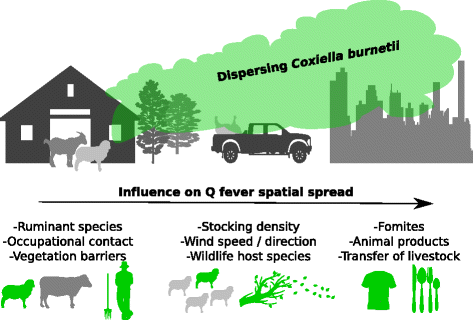Airborne geographical dispersal of Q fever from livestock holdings to human communities: a systematic review and critical appraisal of evidence
- PMID: 29764368
- PMCID: PMC5952368
- DOI: 10.1186/s12879-018-3135-4
Airborne geographical dispersal of Q fever from livestock holdings to human communities: a systematic review and critical appraisal of evidence
Abstract
Background: Q fever is a zoonotic disease caused by Coxiella burnetii. This bacterium survives harsh conditions and attaches to dust, suggesting environmental dispersal is a risk factor for outbreaks. Spatial epidemiology studies collating evidence on Q fever geographical contamination gradients are needed, as human cases without occupational exposure are increasing worldwide.
Methods: We used a systematic literature search to assess the role of distance from ruminant holdings as a risk factor for human Q fever outbreaks. We also collated evidence for other putative drivers of C. burnetii geographical dispersal.
Results: In all documented outbreaks, infective sheep or goats, not cattle, was the likely source. Evidence suggests a prominent role of airborne dispersal; Coxiella burnetii travels up to 18 km on gale force winds. In rural areas, highest infection risk occurs within 5 km of sources. Urban outbreaks generally occur over smaller distances, though evidence on attack rate gradients is limited. Wind speed / direction, spreading of animal products, and stocking density may all contribute to C. burnetii environmental gradients.
Conclusions: Q fever environmental gradients depend on urbanization level, ruminant species, stocking density and wind speed. While more research is needed, evidence suggests that residential exclusion zones around holdings may be inadequate to contain this zoonotic disease, and should be species-specific.
Keywords: Airborne dispersal; Coxiella burnetii; Geographical contamination gradient; Q fever; Spatial epidemiology; Zoonotic disease.
Conflict of interest statement
Ethics approval and consent to participate
Not applicable.
Competing interests
RMS declares that he is an editorial board member of
Publisher’s Note
Springer Nature remains neutral with regard to jurisdictional claims in published maps and institutional affiliations.
Figures

References
-
- Vaglia A, Di Fabrizio N, Dal Pra P. Q fever: clinical epidemiological remarks on our case report. Giornale di Malattie Infettive e Parassitarie. 1984;36(12):1343–1345.
Publication types
MeSH terms
LinkOut - more resources
Full Text Sources
Other Literature Sources

